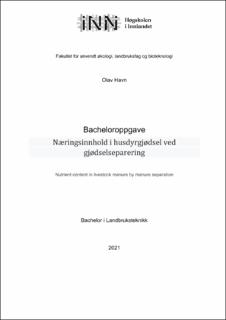| dc.description.abstract | Norsk:
Gjødselseparatorer separerer husdyrgjødsel til en fast- og en væskefraksjon som gir husdyrgjødsla nye muligheter og fordeler. I denne oppgava er det undersøkt hvordan næringsinnholdet endrer seg ved separering, fjerningseffektiviteten, seperasjonsindeksen og massefordelingen av fraksjonene.
Totalt 19 gjødselprøver fra 5 forskjellige opphav er analysert i Excel ved hjelp av formler for effektivitet, fordeling og parvis t-test.
Gjennomsnittlig tørrstoffprosent ble funnet til å være 7,9 i useparert husdyrgjødsel, 4,9 i væskefraksjonen og 26,9 i fast fraksjon. Nitrogeninnholdet hadde en signifikant økning i fast fraksjon, og ingen signifikant forskjell i væskefraksjonen. Ammonium-N hadde en signifikant reduksjon i fast fraksjon og ingen signifikant forskjell i væske-fraksjon. Fosforinnholdet hadde en signifikant økning i fast-fraksjon og en signifikant reduksjon i væske-fraksjonen. For kaliuminnholdet ble det funnet en signifikant reduksjon i væskefraksjonen, men ingen signifikant forskjell i fast fraksjon.
Fjerningseffektiviteten ble regnet ut til 0,39 for tørrstoff, 0,29 for fosfor, 0,11 for nitrogen, 0,09 for kalium og 0,02 for ammonium-N.
Separasjonsindeksen ble regnet ut til 0,49 for tørrstoff, 0,30 for fosfor 0,20 for nitrogen, 0,13 for kalium og 0,12 for ammonium-N.
Fast fraksjon utgjorde i gjennomsnitt 0,16 av utskilt masse, mens væskefraksjonen utgjorde 0,84.
Det trengs mer forskning for å bekrefte resultatene på grunn av lite tallmateriale. Resultatene gir likevel en god pekepinn og er særlig interessante med tanke på fosfor. | en_US |
| dc.description.abstract | English:
Manure separators separate livestock manure into a solid and a liquid fraction that gives livestock manure new opportunities and benefits. In this thesis I have examined how the nutrient content change by separation, the removal efficiency, the separation index and the mass distribution of the fractions.
A total of 19 samples of livestock manure from 5 different origins were analyzed in Excel using formulas for efficiency, distribution and pairwise t-test.
The average dry matter percentage was found to be 7.9 in unseparated livestock manure, 4.9 in the liquid fraction and 26.9 in the solid fraction. The nitrogen content had a significant increase in solid fraction, and no significant difference in the liquid fraction. Ammonium-N had a significant decrease in solid fraction and no significant difference in liquid fraction. The phosphorus content had a significant increase in solid fraction and a significant decrease in liquid fraction. For the potassium content, a significant reduction in the liquid fraction was found, but no significant difference in solid fraction.
The removal efficiency was calculated to be 0.39 for dry matter, 0.29 for phosphorus, 0.11 for nitrogen, 0.09 for potassium and 0.02 for ammonium N.
The separation index was calculated to be 0.49 for dry matter, 0.30 for phosphorus 0.20 for nitrogen, 0.13 for potassium and 0.12 for ammonium N.
The solid fraction had a mass distribution of 0.16, while the liquid fraction was calculated to 0.84.
More research is needed to confirm the results, due to a small number of samples. However, the results give a good indication and are particularly interesting when it comes to phosphorus. | en_US |
